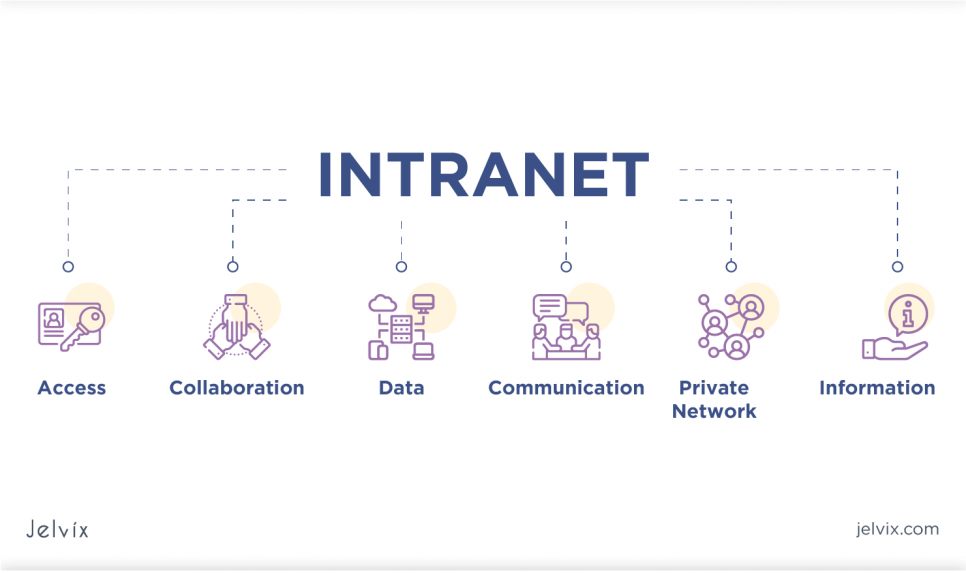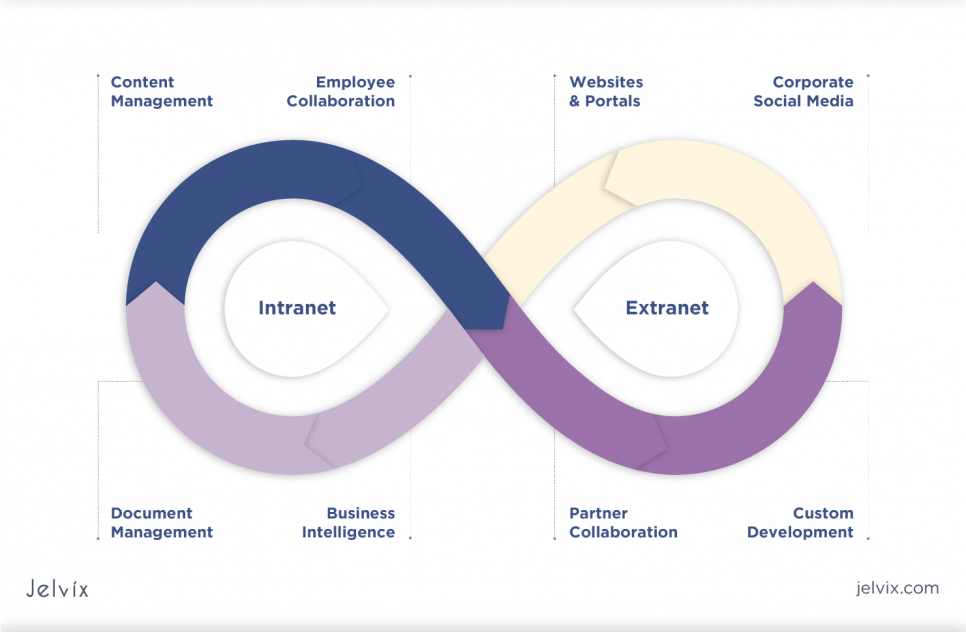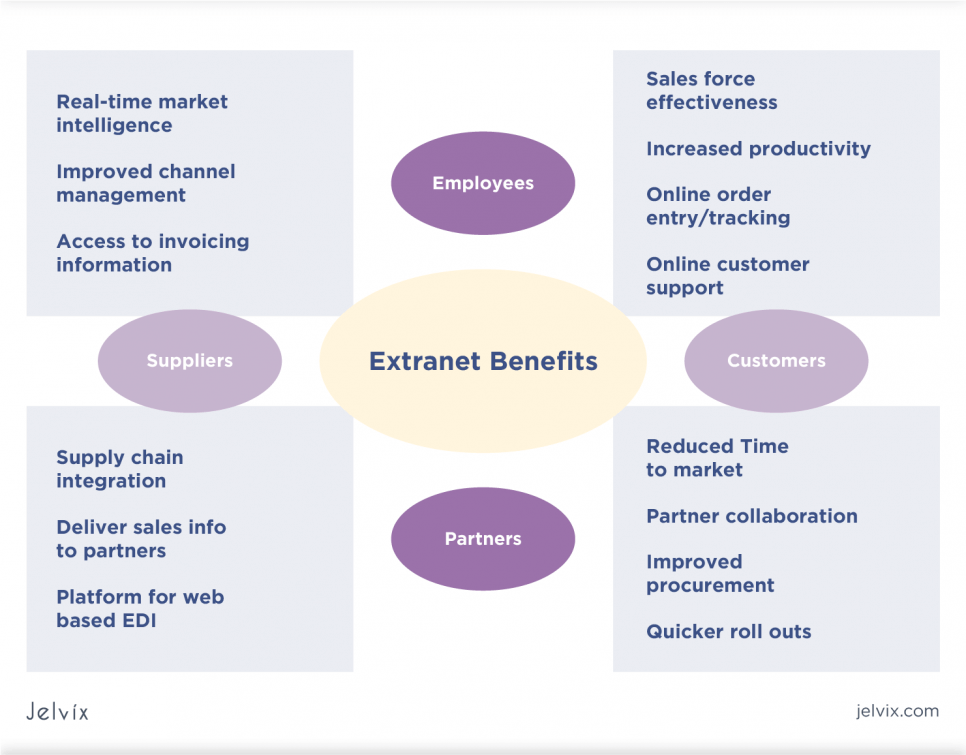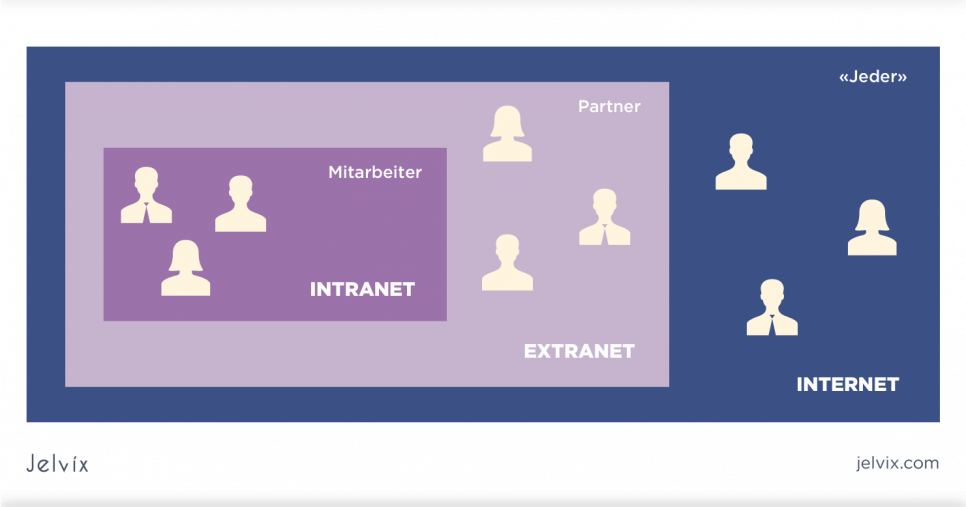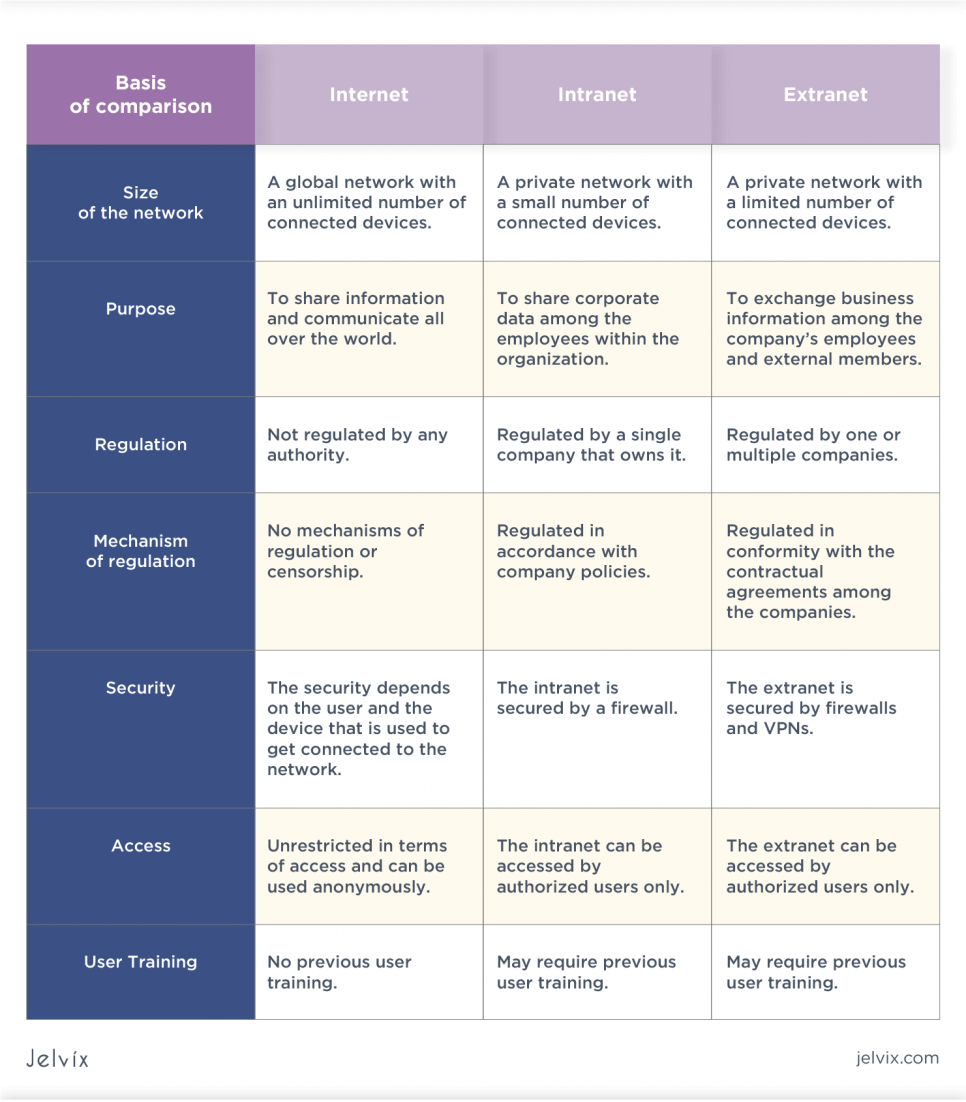Modern businesses derive maximum benefit from implementing digitalization and technologies in workplaces. Due to the recent situation in the world, more and more companies have started to adopt intranet and extranet platforms to support the collaboration of remote teams and improve the quality of virtual work environments.
If you’re not quite acquainted with these technologies, the terms – intranet vs internet vs extranet may sound quite similar to you. But although they have the same purpose: sharing information and increasing collaboration and communication, they are not the same.
With that in mind, we prepared this article to help you better understand what is what. Further, we are going to explore the internet, intranet, and extranet definitions, the advantages they bring to businesses and explain key the differences among these notions.
What is the Internet?
When it comes to the size and number of users, the internet is the largest network accessible to billions of people all over the globe. According to Cisco’s Annual Internet Report, nearly 2/3 of the global population will be able to access the internet by 2030.
The internet is a global network with millions of computers interconnected to communicate with each other and share information. There is no centralized server or controller that controls it. The internet works thanks to the web of networked devices – computers, data centers, servers, routers, repeaters, satellites, Wi-Fi, etc. that allow digital information to travel across wireless signals and data lines constantly.
It uses the TCP/IP (Transmission Control Protocol / Internet Protocol) for data communication. These two protocols work together to assure data transfer to the intended destination within the network. The IP protocol defines a unique IP address for the device or application the data is delivered to, while the TCP protocol is used to transfer and route data through the network.
At large, the internet is unrestricted and uncensored. There’s no single organization or a person that can entirely control it. The absence of regulation is one of the main internet and intranet differences.
Benefits of Using the Internet
It’s a no-brainer that the benefits the internet brings for businesses are invaluable. Let’s take a look at some of them:
– Ability to Reach Unlimited Markets
The internet reach is not limited to a certain location. It means that you can present your goods or services to the entire world and expand your market whenever you want. Moreover, it provides businesses with the ability to target specific markets without exerting a lot of effort. You can use blogs, social media, networking groups, and forums to talk about your products and engage a new audience.
– Low-Cost Marketing
The internet offers a wide range of both free and cost-friendly ways to promote your brand. For example, you can post interesting content on your blog, use social media marketing, create personalized email marketing campaigns, or even purchase advertising space on other websites.
– Ease of Transactions
In 2020, the internet became a preferred means of making purchases for over two billion people. The network makes it easy for businesses to sell their products online. From the advanced e-commerce platforms to online payment services – the internet, nowadays, supports the customer journey from the first interest in the product until the moment of purchase.
– Access to Information
Information is the new oil in the business world. The internet provides to ability to find, access, and process information fast. So no matter whether you are looking up new marketing strategies, assessing the competitor market, or looking for potential business partners – the internet allows you to gain access to the requested data in a matter of mere seconds.
– Internal & External Communication
The internet allows improving internal and external communication processes in the company. It fosters collaboration within teams by offering the ability to organize teamwork in shared calendars, monitor tasks, communicate in chats and via email. On the other hand, it improves communication with customers by allowing them to reach out to your brand via email, customer support chat, contact form on your website, social media messengers, etc.
Drawbacks of using the Internet
As any coin has two sides, the internet has its pros and cons too. While the number of benefits is definitely larger, it still has several drawbacks, namely:
– Malware and data thefts
Hacking and virus threats are ubiquitous on the internet. The users can download and install malicious software and infect not only their computers but also the whole office network. Of course, infected computers may cause a lot of financial and data losses.
Moreover, data breaches, which are the results of hacking and cyberattacks, can also cost a lot for the average company. According to an IBM security report, it takes up to 277 days to identify and contain the data breach, and its global average total cost in 2022 has reached $4.35 million.
– Impersonalization
Another significant drawback of the internet is the limited face-to-face communication with your target audience. In most cases, companies that are run entirely online tend to see their customers rarely. The lack of in-person contact makes it difficult to personalize communication, understand your audience, and establish a strong rapport and loyal relationships with them.
– High competition
The wide accessibility of the internet makes it the main asset for growing businesses of any size and type. It all results in an increased level of competition among online businesses. To stay afloat in any competitive industry on the net, company leaders have to always keep their fingers on the pulse and be ready to adjust to the business strategies to the market’s ever-changing demands.
What is an Intranet?
An intranet is a private, secure network used by employees for internal communication and information sharing within a company or organization. It is primarily aimed at providing the staff with easy and fast access to important business data, links, databases, and applications.
The intranet vs internet work principles are much alike. Both networks use the same TCP/IP protocols for data exchange. However, the intranet is a private network that can be accessed only by registered users with valid usernames and passwords.
The size of the intranet also varies from company to company. It is made of corporate servers and is usually restricted to a definite local area network (LAN) or wide area network (WAN). In other words, the intranet may be accessed over one building, area, or even country. Moreover, some international corporations maintain intranets among various countries by using fiber-optic connections.
Depending on its structure, the intranet may also be accessed remotely by using internet-connected devices. In this case, remote access is supported by using VPN techniques. They ensure that the remote connection is secure and encrypted.
The Key Functionality of the Intranet Embraces:
– Staff information management. Each employee has their own profile that includes contact information (name, address, email, phone number, etc.), their position in the company, department, responsibilities, etc.
– Content management. Intranets allow storing, creating, editing, and publishing a wide range of digital content securely. Employees can share documents, news, templates, guides, etc., and use them to streamline business processes.
– Staff communication and collaboration. Intranets provide the ability to create department and team sites to organize the work on the projects, share progress on tasks and information. They also offer tools for instant messaging (chats) and holding video conferences.
– Projects and task management. The intranet can be used to manage and discuss projects, tasks, and deadlines.
– Learning management. The intranet allows organizing staff training from the initial point of scheduling dates to delivering content and assessing knowledge.
– Staff self-service tools. Employees can issue a number of requests via intranets, including requests for equipment maintenance, sick leaves, holidays, vacations, benefits, training, etc.
Among the efficient examples of what is the intranet used for are:
– HR intranets that allow organizing the staff documentation;
– Corporate intranets that enable employees to store and share data;
– Public Sector intranets that allow sharing templates and forms for bureaucratic procedures;
– IT department intranets to effectively manage projects;
– Real Estate Intranets that are used to connect agents and brokers.
Benefits of using an Intranet
In the business context, an intranet may be extremely beneficial in the workplace. Here’s how:
– Improves Internal Collaboration and Communication
Modern intranets encourage teams to cooperate and communicate with each other. Features for instant messaging, real-time discussions, exchange of ideas in comments, simultaneous work on documents provide employees the ability to interact and work together even without being at the same location.
– Enhances Employee Productivity
A well-rounded intranet solution can save a lot of time spent on searching the needed information or switching across all the business apps. It eliminates the need to check messengers, mailboxes, open video conferencing apps, and project management tools to see the updates or discuss tasks. By having everything necessary for work on one page, employees get less distracted and become more productive.
– Simplifies Employee Onboarding
The right intranet solution can make the first days at work significantly easier. New employees can use it to get acquainted with the workflows, find out more about their peers and gain insights into the culture & values of the company.
– Builds a Transparent Culture
Intranets create an environment where employees can share their thoughts on projects and previous experiences freely. Anyone can create articles, like, and comment on everything shared within the company. It brings transparency into the company’s culture, encourages each employee to contribute, and increases the degree of trust both at the team and company level.
Drawbacks of using an Intranet
Though the intranet has a number of great features, it has disadvantages too. Among the most notable are:
– Costly implementation
Building and implementing intranet solutions may be expensive and time-consuming. The amount of investments into implementation varies depending on the structure, the number of users, and security measures. In addition, to be used effectively, the intranet requires employee training. All these factors increase the total amount of time and costs spent on the implementation.
– Complex to maintain
Intranets have the reputation of being hard and costly to maintain. As with any other portals, they need to be properly managed to keep working efficiently. Software updating, server upgrading, training of the new hires, improvements, and modifications – to ensure that all these are done, a company should either have a dedicated IT staff to handle the network or hire a third-party development company.
– Security threats
Although intranets embrace a lot of security measures, they still are not perfect in terms of security. When the company’s computers are interconnected, even one infected machine may give access to the confidential information shared within the network to some malicious actor. Therefore, the employees have to be educated about the importance of using strong passwords and threats of downloading spyware or malware from the internet.
What is an Extranet?
An extranet is a private, secure network aimed at sharing business information with partners, suppliers, current and potential customers, vendors, and other businesses. It establishes a centralized channel for communication between the organization(s) and outside parties.
The extranet is often viewed as a hybrid of the intranet and the internet. It uses the same protocols and connectivity as the internet but has a restricted nature of intranet and can be accessed only by the selected number of authorized users.
The extranet may be owned, controlled, and supported by one or multiple organizations. Of course, the information shared within the extranet is private and has to be secured appropriately. The security is ensured by incorporating firewall server managements, encryption of messages, using digital certificates, and virtual private networks (VPNs).
The Key Functionality of Extranets Covers:
– Collaboration with business partners. The extranet can be used for bid management, document sharing and co-authoring, vendor assessment and approval, etc.
– Communication with customers & customer self-service. Extranets can be used to find and fix issues related to the products and gather customer feedback. Buyers can issue service orders, ask questions, use the knowledge base to find answers to common problems, and share their experience and opinions about your brand.
Among the prominent extranet examples are:
– Healthcare extranet portals where doctors, patients, and vendors can exchange health data securely;
– School extranets to organize collaboration among students, teachers, and administrative workers;
– Retail Extranets, used to connect companies and suppliers to order inventory, monitoring shipping, etc.
Learn more about the fundamental differences between E-Commerce vs E-Business.
Benefits of using an Extranet
Extranet offers a range of strategic benefits to businesses. Here are some of them:
– Streamlined Business Process Management
The right extranet solution can automate a lot of routine business operations related to supply chain management (online ordering, order tracking, inventory management). In addition, it allows to instantly change and update important information (e.g., prices, inventory availability, etc.).
Customer and vendor extranets also reduce the need for calls, emails, and meetings. The networks ensure that the right information will be accessible to the right people and won’t get out-of-date.
– High Security of Data
When it comes to business, data security is of utmost importance. In most cases, sharing information and sending documents via email or other boxes is unsafe and can lead to potential data leaks. Modern extranets offer a secure environment for data exchange. They are equipped with advanced security measures like multifactor authentication, access control, data encryption, hashing, etc.
– Increased Customer Satisfaction
Extranets make your business 24/7 accessible for your customers. The software provides timely and seamless access to their personal information associated with your business (the history of purchases, invoices, etc.). More importantly, your customers gain the ability to ask questions and find information about products in the network around the clock. In this way, it ensures a better customer experience and eliminates the barriers created by time zones.
Drawbacks of using an Extranet
Yet, nothing is perfect in this world, and extranets have their flaws. Among their drawbacks are:
– Implementation & maintenance costs
As with any other application, the implementation and maintenance of the extranet require some cost investments. These expenses cover hardware, software, staff training, and repair costs (if needed). However, if properly implemented, the system may also save money by automating some time-consuming business processes.
– Security issues
Even though extranets contain many security features, the sensitive data shared there can still get into the wrong hands. It may happen due to compromised passwords or IDs that will allow an outsider to access confidential information.
Extranet vs Intranet vs Internet: Key Differences
If you’ve reached this part, you’ve probably noticed that the key differences among the intranet, internet, and extranet involve several aspects, including purpose, accessibility, regulation, and security. Let’s compare these three systems in the table: Intranet vs Extranet: What is the best option for your business?
At the end of the day, both intranets and extranets provide companies with the ability to organize a collaborative digital workspace. However, deciding which system is better for your business depends mostly on the needs of your business.
If you need a platform that will improve internal communication processes, information exchange and boost the employee experience, an intranet is the best match for you. And on the contrary, if you want to foster strong relationships with business partners, customers, vendors, and suppliers, investing in an extranet platform is the right idea.
In the modern context of switching to remote work mode, a significant number of companies implement both solutions. When perfectly combined, extranet and intranet help companies smoothen business workflows, ensure secure access to relevant information, and prevent communication crises.
Final Words
Internet, extranet, and intranet – all three networks offer a range of advantages to businesses. However, although at the heart of all networks lies the same aim – the exchange of data, they are drastically different in terms of security, size, and access.
If you want to implement a successful digital workplace and improve collaboration but do not know what solution will better suit your needs, our experts are willing to help you. Just drop us a line, and our development team will assist you in selecting the system that will be a perfect match for your business.
Need a qualified team?
Access the talent pool to scale your team capacity.



